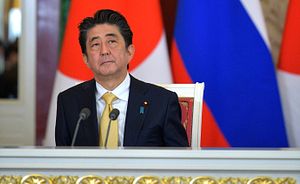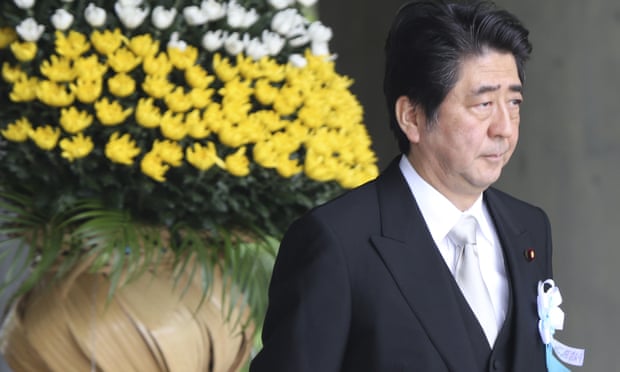Shinzo Abe and the Slow Death of Article 9
Shinzo Abe would see the anti-war section of the Japanese constitution weakened or rewritten, but this would end an interesting and important experiment in international relations.
Jack Ramsey Mar 27, 2017

Prime Minister Abe and President Obama at the Pearl Harbor Memorial
In 1945, President Harry S. Truman appointed General Douglas MacArthur to make a liberal democracy out of the husk of an imperial country that had twice been devastated by nuclear weapons. Bypassing all cooperation with the Japanese, MacArthur convened a group of Americans to draw up a new constitution. He gave them a week.
He then sent the completed document to the acting Japanese government and not-so-subtly implied that the survival of Japan’s imperial institution was conditional on the passing of the new, democratic constitution. With the constitution finalized and the ultimatum issued, acting Prime Minister Shidehara endorsed it wholeheartedly. He painted the new constitution as the way forward for postwar Japan — and especially so for a unique section: Article 9.

A city block in Tokyo, 1945
It holds that Japan shall “renounce war as a sovereign right of the nation and the threat or use of force as means of settling international disputes.” The government of Prime Minister Shinzo Abe has since reinterpreted Article 9 to allow for the maintenance of “Self-Defense Forces.” This is what allowed Japan to send troops to Iraq (although they were in a purely humanitarian role) and what what would allow Japan to defend itself against a theoretical foreign invasion.
Abe took office in 2012 and since then has tightened the grip of the Liberal Democratic Party (LDP) on parliament. In 2016, the LDP and its coalition partner Komeito won 70 out of the 121 seats that were up for election in Japan’s upper house, the House of Councillors. In theory, any party endowed with such electoral success must be doing something right. But the LDP has been in power for all but four years since 1946 and currently governs without the inconvenience of any serious opposition.
Now, after the recent election, the LDP and Komeito, along with smaller ideologically related parties and independents, constitute two-thirds of both houses.This should make any fans of Article 9 nervous. Shinzo Abe has made no secret of his personal goal to repeal or rewrite the section to allow Japan to raise a conventional military — something that can only be done with a two-thirds supermajority in both houses.
Gavan McCormack, an emeritus professor of the Australian National University, notes that “[Abe’s] revisionist historical views and hardline stance on territorial disputes [has] disturbed the U.S. government and outraged Japan’s neighbors.” Nevertheless, the United States has continued to pursue increased military cooperation, legitimizing and enabling Abe’s nationalist agenda. “Abe’s proposal to ‘shrug off the husk of the husk of the postwar state’ and ‘recover Japan’s independence,’” he argues, “could only mean replacing U.S.-imposed structures with Japanese — pre-1945 fascist and emperor-worshiping — ones.”
So Prime Minister Abe does not look to Japan’s future in his reasoning for constitutional reform, but to its imperial past. Yet even before Trump, America has been looking to offload security responsibility to its allies. This is one case where Trump’s argument (that America’s allies should take more responsibility by increasing defense spending) falls on sympathetic ears.

Shinzo Abe and Donald Trump playing golf at Trump’s Mar-A-Lago resort in February 2017
(内閣官房内閣広報室, Creative Commons)
In 2014, knowing that an amendment to the constitution was still far off, Abe took advantage of his relatively powerful position to bypass the amendment process and institute a “reinterpretation” of Article 9. This new reading of constitutional law allows Japan the right to “collective self-defense” (so that it can come to the aid of an ally under attack).
For almost all of postwar history, Japan abided by something called the “Yoshida Doctrine,” which held that Japan should focus entirely on rebuilding its economy, rather than spending money on defense. Abe can now make his case for reinterpretation and amendment by arguing that the doctrine is no longer necessary. After its rapid recovery and subsequent transformation into one of the largest and most modern economies in the world, why should Japan limit its military power
Accompanying the advent of widespread wealth, nationalist sentiment has also flared up; and the LDP has long called for more Japanese involvement in global security endeavors. The party leadership believes that if Japan’s Self-Defense Forces begin to act more like a conventional military, Japan will have a stronger case for a permanent seat on the UN Security Council. On top of these reasons, Japan is receiving pressure to both from a standoffish China and a United States that would like to delegate more responsibility for security in East Asia.
There are numerous contradictions between a constitution that explicitly forbids “land, sea, and air forces, as well as other war potential” and a government that has chosen to interpret the constitution to allow for the Self-Defense Forces. Many constitutional scholars have pointed out that the forces are legally dubious, as has Abe himself. Instead of scaling back the military, he has used its questionable legality to substantiate his argument for amendment, but he still faces many significant institutional barriers.
The Democratic Party of Japan, even if it failed to provide a viable alternative to the LDP’s policies, found itself united by opposition to amendment of the pacifist clauses in the constitution. And Komeito, the LDP’s junior coalition partner, (and without which the LDP cannot meet the supermajorities required for constitutional amendment) is a Buddhist party dedicated to pacifism. It originally objected to Abe’s 2014 reinterpretation, but conceded reluctantly rather than threaten its position in the governing coalition. Recently, though, Natsuo Yamaguchi, Komeito’s leader, has warned against further weakening of Article 9.
However, recent polls indicate that that most Japanese voters don’t understand the implications of Article 9 or of amendment. Unfortunately, it would seem that a side effect of Abe campaigning on an economic agenda (Abenomics, as it’s often called) and generally opting not to make a public case for constitutional reform is that voters are confused about that section of the constitution.
What opinion polls have been taken indicate a deep support for Article 9 among the Japanese population as they believe that it has kept their country out of war. The popularity of the current constitution, as well as the support it enjoys outside of the LDP (both from the Democratic Party and Komeito) indicate that it will not be rewritten in the near future. And if this wasn’t troubling enough for those calling for amendment, the constitution has not been amended since it was first put to the Japanese government in 1946.
With that said, even if Article 9 is not in mortal danger, it is already the victim of a much slower death. One might reasonably question what the point of a pacifist constitution is if Japan can not only still go to war but also be dragged into war to defend an ally (as it can under Abe’s interpretation). The Economist points out that “for a document cobbled together during a few hectic days in 1946, in bombed-out Tokyo, Japan’s constitution has weathered the test of time.” Indeed it has — at least technically — but true supporters of Article 9 should already be mourning the death of that unique experiment in international relations.
OPINION
Shinzo Abe Is Quitting, and Leaving a Trail of Scandals Behind
Will he ever face the Japanese people’s calls for accountability?
Aug. 30, 2020
By Koichi Nakano
Mr. Nakano is a political scientist in Japan.

TOKYO — Prime Minister Shinzo Abe’s announcement on Friday that he would resign because of poor health was a rather abrupt end for a supposedly strong leader. Mr. Abe has ruled Japan, most recently, for a record seven years and eight months: He is the country’s longest-serving prime minister.
The decision was a surprise — and yet it wasn’t.
A chronic illness was also the reason Mr. Abe cited when he suddenly resigned from his first stint as prime minister in 2007.
The matter of his health had surfaced again a couple of weeks ago when, after he underwent a medical checkup, a former minister and close associate of Mr. Abe’s publicly expressed concern that the prime minister was overworked and might have to be “forced” to get a few days’ rest.
That seemed strange because Mr. Abe certainly hadn’t appeared to be working too hard. In fact, most Japanese people had grown critical about his not doing enough to manage the pandemic and its economic impact.
Mr. Abe was largely absent from public view after the coronavirus broke out in Japan early this year, popping up occasionally only to announce ill-conceived policies: His plan to distribute two washable cloth masks — so-called Abenomasks — to every household was quickly derided as futile and inefficient.
At the same time, he was still mired in various scandals from the past several years — and still failing to provide convincing accounts of his behavior.
Both the Moritomo Gakuen and Kake Gakuen scandals prompted allegations that Mr. Abe had granted special favors to ideological companions or his friends. The Moritomo Gakuen case, about a heavily discounted land deal, involved a cover-up by Finance Ministry officials, including the doctoring of public documents. Mr. Abe continues to deny any involvement (or any by his wife), but he has apologized on behalf of the government for the document tampering.
Controversy had also been growing around the cherry-blossom-viewing party the prime minister hosts every year: an official government event paid for by taxpayer money that has kept getting more and more lavish, and increasingly has seemed designed to reward Mr. Abe’s and his party’s loyal supporters. When the opposition started asking questions about the 2019 event, the Cabinet Office shredded documents listing that year’s attendees, in violation of government rules.
After that, coronavirus or not, the scandals and the cronyism continued.
In January, the prime minister bent or reinterpreted — call that what you will — a law so that a favorite prosecutor could stay in the job past the mandatory age of retirement. Then he tried to have the law formally amended — a move that looked like an attempt to retroactively validate what he had already improperly done. But after the prosecutor was forced to resign over illegal gambling, Mr. Abe had to retract the plan.
In June, the justice minister and a close aide of Mr. Abe, Katsuyuki Kawai, and his wife, Anri, a member of the upper house of Parliament from Mr. Abe’s Liberal Democratic Party, were arrested and charged with vote buying during the election for that chamber last year. The Kawais received 150 million yen (more than $1.4 million) from the L.D.P., over which Mr. Abe presides. (The prime minister denies any involvement. The Kawais have pleaded not guilty to the charges.)
In short: Mr. Abe has had a lot of explaining to do — to Parliament, the media, the public. And yet he has done as little of that as possible.
Mr. Abe closed the ordinary session of Parliament, known as the Diet, on June 17. On July 31, the opposition called for an extraordinary session as soon as possible. Although such requests are a right guaranteed by the Constitution, Mr. Abe rejected it: It was the third time he has done so.
Before Mr. Abe’s resignation announcement on Friday, his last proper news conference had been on June 18 — even though a prime minister’s news conferences with Japanese media are notoriously staged and meek affairs.
No wonder that by then public support for Mr. Abe had already dropped to its lowest levels since the start of the coronavirus crisis.
Japan has been relatively successful in managing the spread of the virus and limiting the death toll, but the government isn’t getting much credit for that. In one opinion poll from mid-August, about 60 percent of respondents said they had a negative view of the Abe administration’s response to the pandemic.
Mr. Abe returned to power in December 2012 vowing to “take back Japan” — a promise to rebuild the Japanese economy with his signature “Abenomics” and “normalize,” as he put it, Japan’s defense policy through rearmament and by reinforcing ties with the United States.
While analysts debate his record — a stock market boosted, but stagnant wages and record government debt; a controversial and unsuccessful bid to revise the Constitution’s pacifist clauses; close ties with President Trump — the L.D.P. is looking for a successor.
Since Mr. Abe is abruptly resigning amid crises and controversies, the L.D.P. is more likely to search for a new leader by consulting a relatively small group of the party’s Diet members and representatives in local chapters than by organizing a full-fledged race with the participation of rank-and-file party members.
If so, the prospects of Shigeru Ishiba, a popular and persistent critic of Mr. Abe’s ways, would seem rather limited.
Mr. Abe had been said to have a soft spot for the docile, if uninspiring, Fumio Kishida, a former foreign minister, but he may now be supporting Yoshihide Suga, his chief cabinet secretary, who is more ruthless, secretive and authoritarian and might have a better chance of defeating Mr. Ishiba.
Whatever Mr. Abe’s eventual legacy, whoever his immediate replacement, one thing already stands out: Japan’s longest-serving leader is leaving office by skedaddling from scandals and evading calls for accountability from the people he is supposed to serve.
Koichi Nakano is a professor of political science at Sophia University in Tokyo.
Despite enormous stature and power, Abe leaves office having accomplished relatively little.
By Jeff Kingston
August 31, 2020

Paradoxically, despite enormous stature and power, Abe leaves office having accomplished relatively little.
While Abe’s legacy may be paltry, he leaves a big vacuum at the center of the world’s third largest economy. None of the potential successors look like they can fill his shoes. On the other hand, they are not beholden to his failed policies, so there is an opportunity for some fresh thinking and more resolute action on Japan’s gathering challenges, especially pandemic countermeasures and the demographic time bomb.
Granted, Abe has drawn international kudos for his grand ambitions, but after nearly eight years with a supermajority in the Diet his legislative achievements are meager and he failed to deliver on most key promises, most notably on the economy. He will always be remembered for Abenomics and the three arrows of monetary easing, fiscal stimulus, and structural reforms, but he didn’t follow through on this bold plan while racking up a mountain of debt. In the end, Abenomics was mostly a branding strategy to generate a buzz rather than a blueprint for economic revitalization. Abe erred with two consumption tax increases and in squandering too much political capital on his Holy Grail of constitutional revision.
This was Abe’s problem in 2006-07 when he prioritized revising the pacifist constitution and drew criticism for quibbling about the level of coercion involved in recruiting young Korean teens to provide sexual services for Japan’s wartime military. Just before elections in July 2007 Abe showed little empathy for people anxious about lost pension records and led the Liberal Democratic Party (LDP) to a landslide defeat, becoming a national pinata with the demeaning sobriquet “kuki yomenai” (clueless). Party elders nudged him toward the exit, and he resigned, citing health problems.
In 2012, Abe made a remarkable comeback, leading the LDP to a landslide victory. Abenomics was a product launch aimed at softening his ideological image and conveying a laser-like focus on pocketbook issues. But fast forward to 2020 and his popular support plunged due to anger over how he managed the COVID-19 outbreak and a series of scandals. It didn’t help that the public didn’t feel the love of Abenomics and has been left treading water.
Although Abe got into politics to revise Japan’s pacifist constitution and rehabilitate its wartime history, few voters warmed to these efforts. Abe eventually realized that he won’t be revising the constitution because support is lacking, and the pandemic is hogging the political bandwidth.
At his sayonara press conference, Abe expressed regret that he didn’t resolve the abduction issue involving Japanese nationals kidnapped by North Korea since the 1970s. The government asserts that dozens remain unaccounted for. This is the issue that catapulted Abe into the national limelight when he was Prime Minister Junichiro Koizumi’s chief negotiator with North Korea and ever since Abe has made it one of his signature policies. He made a point of seeking U.S. backing and Donald Trump raised the issue when meeting with Kim Jong Un.
Abe’s marginalization from the North Korea dialogue, however, reinforces a sense that his diplomacy has been more feckless than effective. He also regretted failing to secure a peace treaty with Russia and surely rues making no headway on territorial disputes with Russia, South Korea, and China. Although advocating a values-driven diplomacy Abe shied from calling out governments on human rights violations or democratic backsliding.
Abe’s advocacy of free trade – including sealing a comprehensive deal with the EU and rescuing the Trans-Pacific Partnership (TPP) after Trump withdrew the United States — are his most notable diplomatic achievements.
At the August 28 press conference, Abe stated that his legacy will be determined by the public and history. He asserted that he expanded jobs and daycare, enacted free education for secondary school students, and changed how people work. He also touted his 2015 legislation that expands Japan’s military commitments to the United States although the Japanese public is strongly opposed.
Problematically, Abe came to power promising to revive Japan through sweeping structural reforms of the economy. Yet, he achieved little of note because the LDP is the party of the status quo – it represents the vested interests that would lose from such reforms. The overall economy was swooning even before the pandemic but due to the pandemic has shrunk below its GDP in 2013, when he started.
Abe also promised to help make women shine, but that hasn’t happened. Women account for only three of his 20 cabinet ministers, about 10 percent of Diet politicians and less than 10 percent of corporate managers. In the World Economic Forum’s Global Gender Gap Report 2020 Japan slipped to 121st place, the lowest among advanced economies, down 10 rungs from the previous year.
In 2020 Abe has been the incredible shrinking prime minister. The public soured on him because he has been arrogant, complacent about managing the COVID-19 outbreak, and embodies the dubious means of old school LDP cronyism. He lurched from crisis to crisis, as numerous scandals eroded public trust and he was called out in social media for his lackluster pandemic response. With Abenomics tanking, diplomacy faltering, and the Olympics on the brink of cancellation, the legacy of a political giant is underwhelming.
Moving forward, what can be done? Abe’s successor has to be more creative in trying to boost consumption to revive the economy. This could involve a temporary income guarantee, expanded job subsidies, and nudging the Bank of Japan to buy up prefectural and municipal bonds to help support rural revitalization projects. Japan needs a global economic rebound but can do itself a favor by tackling Abe’s unfinished business on structural reforms to boost productivity, empower women, and adopt sensible immigration policies to alleviate growing labor shortages.
Is anyone up to the task? Alas, probably not.
Jeff Kingston is Director of Asian Studies at Temple University Japan.
Japanese academics add to pressure on prime minister during runup to 70th anniversary of end of Pacific war

Justin McCurry in Tokyo
Japanese historians have urged prime minister Shinzo Abe to offer an honest account of the country’s wartime use of sex slaves in the runup to the 70th anniversary of the end of the Pacific war.
In a statement released this week that echoes a demand recently issued by overseas experts, 16 groups of academics, including the Japanese Society for Historical Studies, said the government must “squarely” confront Japan’s wartime conduct.
Despite signs of an improvement in Sino-Japanese ties, speculation is building that Abe’s conservative administration will not repeat an official apology to the “comfort women” – a euphemism for as many as 200,000 women, mostly from the Korean peninsula, who were forced to work in military brothels.
Early indications are that Abe will also make no reference to Japan’s colonial rule and aggression on mainland Asia in the first half of the 20th century, when it invaded the Korean peninsula and parts of China. The omissions would mark a clean break with apologies issued by his predecessors on previous war anniversaries, and risk raising tensions with South Korea and China.
The Japanese academics said in their statement that comfort women had been the victims of “unspeakable violence as sex slaves”.
They added: “As recent historical studies have shown, victims were subjected not only to forced recruitment, but also to conditions of sexual slavery which violated their basic human rights. By continuing to take the irresponsible stance of denying the facts of wartime sexual slavery in the Japanese military, certain politicians and sections of the media are essentially conveying to the rest of the world that Japan does not respect human rights.
“This kind of attitude tramples further upon the dignity of the victims, who have already borne terrible hardships.”

While Abe has said he will not alter the wording of an apology to survivors of military sexual enslavement issued in 1993 by the then chief cabinet secretary, Yohei Kono, he has resisted pressure to repeat the apology, most recently during his address to a joint session of the US congress.
Advertisement
The Japanese historians urged “all concerned politicians and media outlets to squarely face up to the damage that Japan inflicted in the past, as well as to the victims”.
The demand comes soon after several hundred academics, mainly from the US and Europe, voiced alarm at attempts to rewrite Japan’s wartime history, and urged Abe to “act boldly” in addressing sensitive issues from the past.

Anger of wartime sex slaves haunts Japan and South Korea
In an open letter, more than 180 scholars called for “as full and unbiased an accounting of past wrongs as possible”. The number of academics who wish to add their names to the protest has since more than doubled to more than 450.
Rightwing revisionists associated with Abe have been emboldened by misreporting of the sex slave issue by the Asahi Shimbun newspaper. Last summer, the liberal daily admitted that it had run a series of articles stretching back to the 1980s that were based on testimony given by Seiji Yoshida, a former Japanese soldier, whose claims were later found to be false.
Abe was one of several conservative politicians who claimed the Asahi’s erroneous coverage had sullied Japan’s reputation abroad.
However, the academics said previous government apologies were not based on the Asahi’s reporting or Yoshida’s testimony, adding: “The existence of forcibly recruited ‘comfort women’ has been verified by many historical records and extensive research.”
Abe has previously questioned the widely held belief that Japanese military authorities coerced the women. He has also said that Japan has apologised enough for its actions during the war.








.png)
